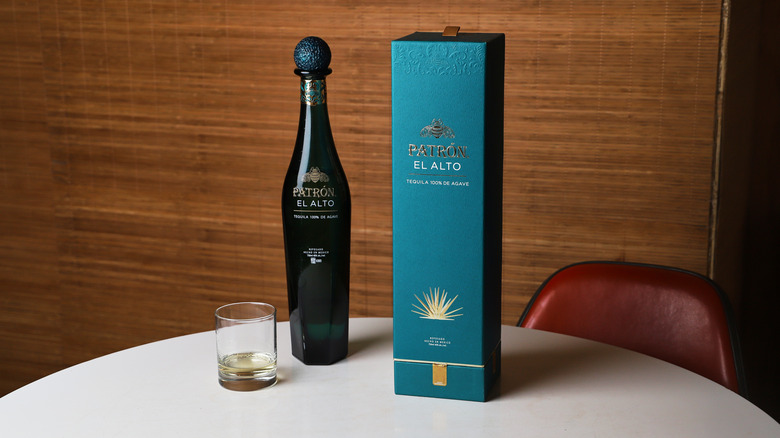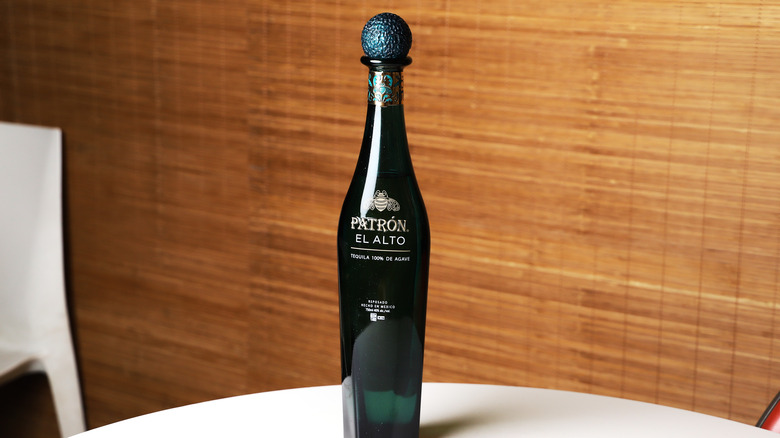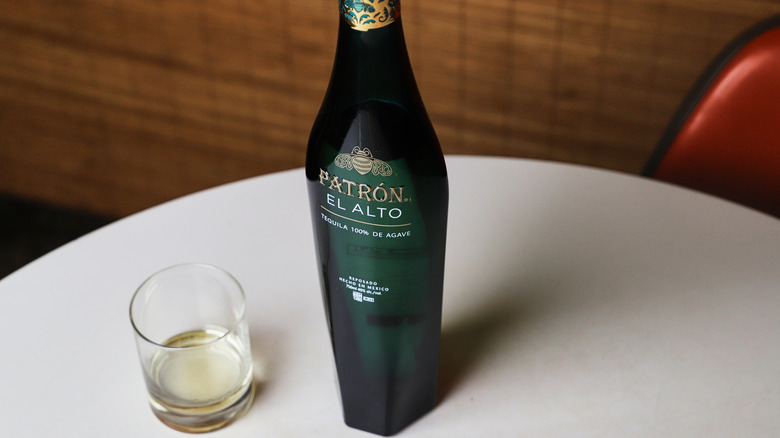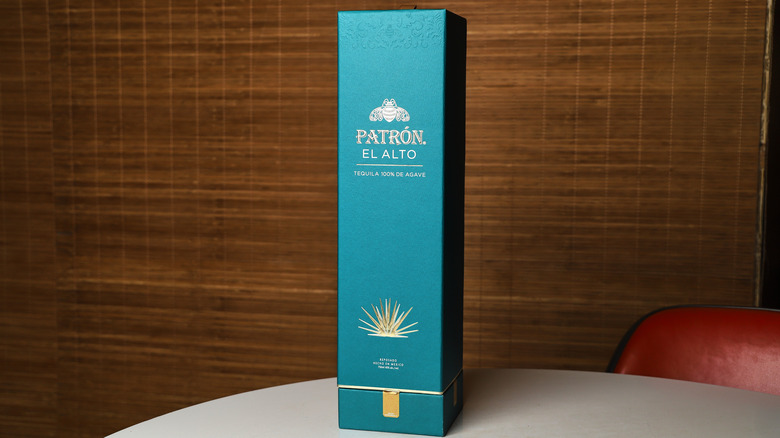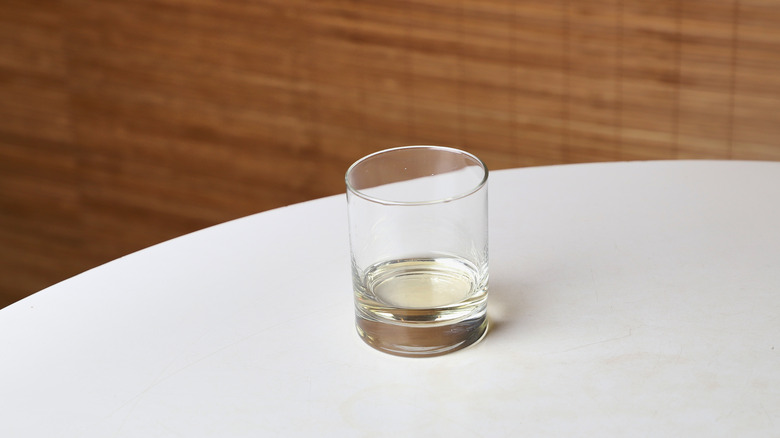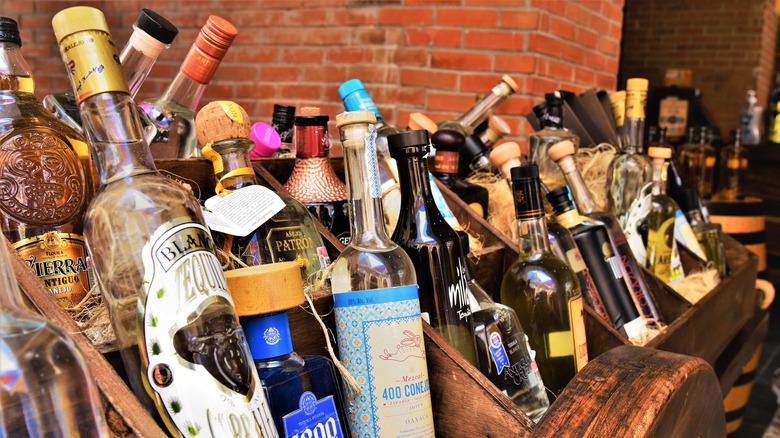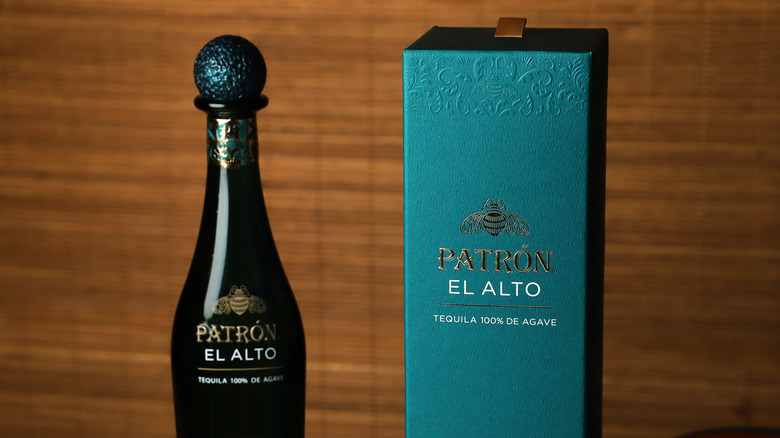We Tried Patrón's Ultra-Premium El Alto Tequila
Patrón, the Mexican-based tequila giant, first splashed onto the market in 1989 and, since then, has become a crowd favorite amongst tequila lovers looking for a high-end margarita, one of the most name-dropped spirits in hip-hop, and America's third best-selling tequila brand (behind Don Julio and Ocho).
Along with the brand's four core agave spirits (Silver, Reposado, Añejo, and Extra Añejo), Patrón boasts a mini-line-up of luxury items under their Gran Patrón label including a triple distilled silver tequila, Platinum, an aged añejo, Piedra, and Burdeos, an añejo finished in Bordeaux barrels. Now, the tequila brand brings to life another extravagant bottle with El Alto, a super glitzy, reposado (or aged) tequila made from Blue Weber Agave.
First released in November of last year, El Alto aims to tempt tequila lovers into spilling their cash on an opulent party beverage Patrón bills as "perfect for momentous occasions big and small." We finally got our hands on a bottle to see what the hype is about and if the beverage lives up to the branding.
What's in the bottle and how is it made?
Like all of Patrón's flagship offerings, the brand never shies away from bragging about its bottle's high-quality content. Made entirely from "the finest" Weber Blue Agave and produced using the Tahona method — a system wherein a volcanic stone pulverizes agave hearts, sometimes with assistance from donkeys — El Alto represents a crossroads for tequila enthusiasts by blending three types of tequila (four-year extra añejo, añejo, and reposado) until Patrón's high-end dream-drink comes to life.
Inhabiting 11 different types of barrels to achieve the brand's desired profile, El Alto claims to deliver a sweet, smooth finish unnecessary of any mixers. Where the brand typically inserts a cocktail recipe when describing how best to enjoy its spirits, Patrón's website solely asks its audience to enjoy its latest creation either on ice or straight up. Even the visual content Patrón created only features El Alto tequila sans mixers, poured into thick, chilled rocks glasses, and celebratory champagne flutes, signaling to their brand's consumers El Alto's sophisticated palette.
How much does El Alto cost?
Clocking in at around $180 for a standard 750-milliliter bottle, Patrón's El Alto seeks to rival the current extravagant industry standard, Don Julio 1942, as a top-shelf choice for tequila-lovers. Cast in a similarly sleek, elongated bottle as Don Julio 1942, Patrón El Alto communicates its lavish price tag with its opulently designed dark, jade container.
At more than three times the price of Patrón's entry-level bottles (Patrón Silver reliably runs their consumers around $50), El Alto still sits below the exorbitant cost of all of their Gran bottles (Platinum goes for nearly $200, Piedra closer to $400, and Burdeos breaks the bank at $500), making the bottle hover somewhere between Patrón's base-level spirits and its upper echelon offerings.
If you're planning on sampling El Alto at a bar, however, a single shot (two ounces) of the elevated beverage would cost you close to $40 to sample, whereas the breakdown, if you're willing to invest in your very own deep-teal bottle of El Alto, averages out to just over $16 per two-ounce serving if you'd like to enjoy the tequila from your couch.
How long it will be available and where can you get it?
Though Patrón hasn't given word on how long their El Alto bottle might stick around liquor stores, it hasn't been given the "limited edition" status as previous bottles like the brand's past David Turman Tequila, its Estate Release, or its 7 Anos Anejo — all of which have been pulled from production. We're guessing Patrón's decision on how long to keep El Alto will be determined by how the public receives the new, celebratory bottle.
However, the rollout of El Alto has been a slow one nationally, as the luxury bottle can only be found within the state lines of California, Florida, Nevada, and New York, with no word on when its availability might expand to the nation's remaining 46 states — though Patrón's website encourages visitors to join a newsletter where El Alto's expansion will be announced first. So, unless you live in or are traveling to any of El Alto's four destinations, the bottle might take a few months to arrive in your home state.
What does it taste like?
By the time we finally got around to pouring ourselves a shot of El Alto, we had already taken in Patrón's promotional material, news articles covering the new beverage, and even a somewhat phoned-in single ("2 Live" by Hitboy featuring Offset inspired, and certainly bankrolled, by Patrón) and our expectations ran high for the contents of our jewel-toned bottle.
El Alto's color correlates with the drink's softness and resembles a light golden amber, similar to the hue of a Chenin blanc wine. The nose of our shot of El Alto (we omitted a rock) only smelled slightly of alcohol, no small feat for a 40% ABV tequila, and we picked out slightly sweet vanilla tones while still distinctly smelling agave. We were struck by El Alto's sweet, almost creme brulee flavor at the beginning of our sips but we were disappointed by how those initial tasting notes refused to bloom into anything more.
While Patrón correctly brags over El Alto's smooth, silky, and refined flavor, we also side-eye spirit companies that seem to want to eliminate any and all characteristics from the liquor itself (we're looking at you, Hendricks Gin), and leave us only with a ghost-like smacking of the botanicals (or in this case agave) used to create the elixir.
Comparing El Alto to similar tequilas
Compared to other Patrón products (Gran Patrón items excluded), El Alto certainly delivers a chicer mouthfeel and overall experience. But once it's measured against a tequila of equal quality, El Alto's appeal beings to melt — but only for its lack of character.
Side by side with Don Julio 1942, El Alto feels like the scrawnier choice; soft to the point of vanishing, El Alto ultimately proves to be so soft-spoken that we couldn't pick up its crucial notes. And when standing next to our favorite two high-end tequilas Fortaleza and El Tesoro, El Alto ultimately feels like a featherweight to more established brands' top-shelf offerings. Comparably priced to Patrón's latest release, Fortaleza flashes more vivid flavors and dimensionality with tones of citrus and earth, while El Alto contains notes of herbs and a verdant atmosphere, tasting nearly hollow and transparent in contrast to our two favored tequilas.
Is it worth buying?
If you're looking for a high-quality tequila in a swanky bottle, we wouldn't dissuade anyone from seeking out a bottle of El Alto (when it finally is available near you); but if you're looking for a tequila with intention and depth, we'd advise you to keep shopping.
Though El Alto achieves one of the smoothest finishes we've ever sipped on, we can't find its purpose other than for drinkers who shy away from the taste, and oftentimes charm, of greater spirits. Seemingly set into production for the bougie drinker who wants to impress more than they want to savor, El Alto, aside from its stylish bottle and big promises, only delivers a sleek emptiness akin to an Instagram filter of the spirits world.
Though we'd be pleased to encounter El Alto at a party, we're more excited to continue sipping our way through the growing catalog of quality tequilas that might embrace the complex textures the agave plant has to offer.
